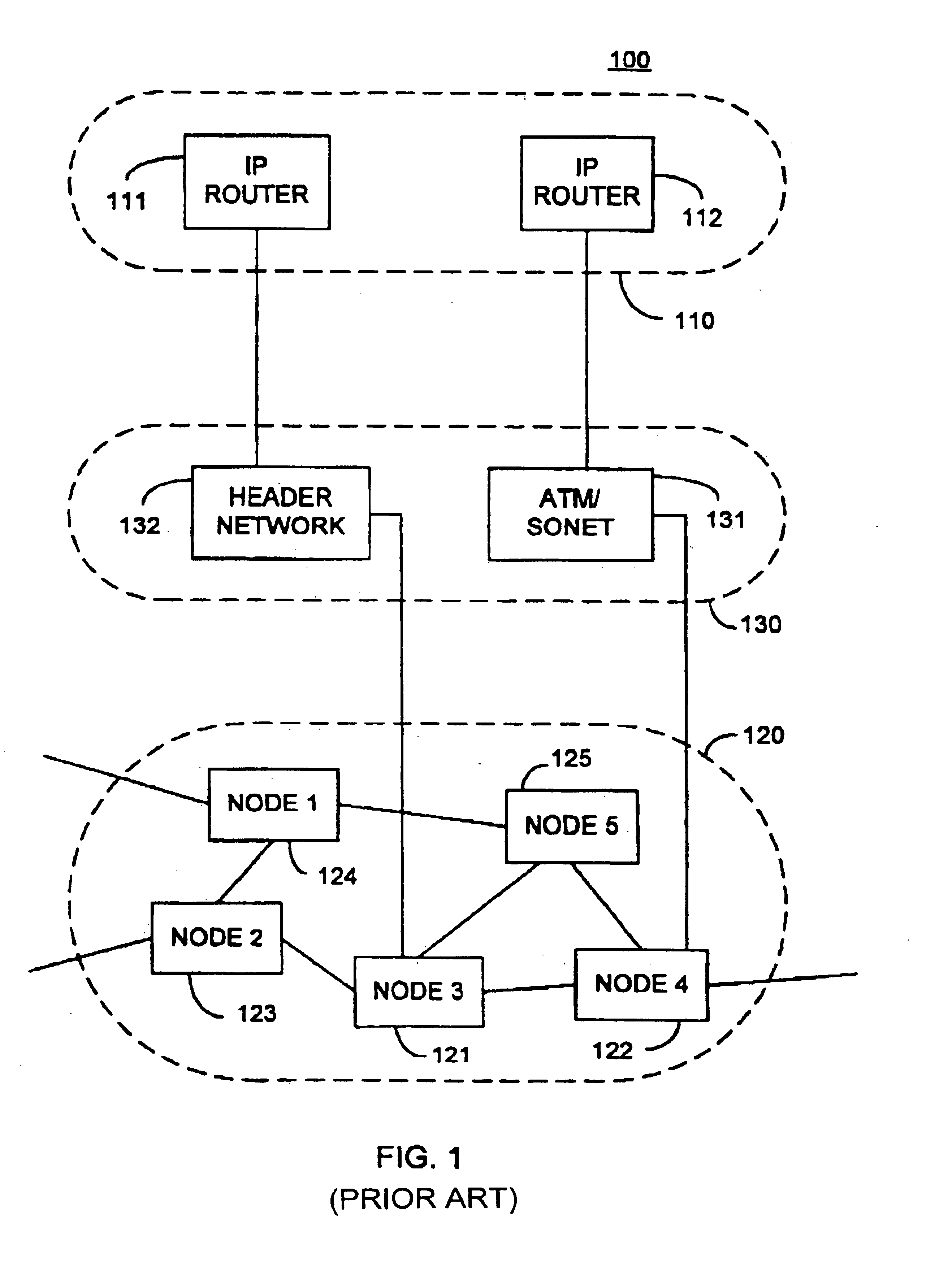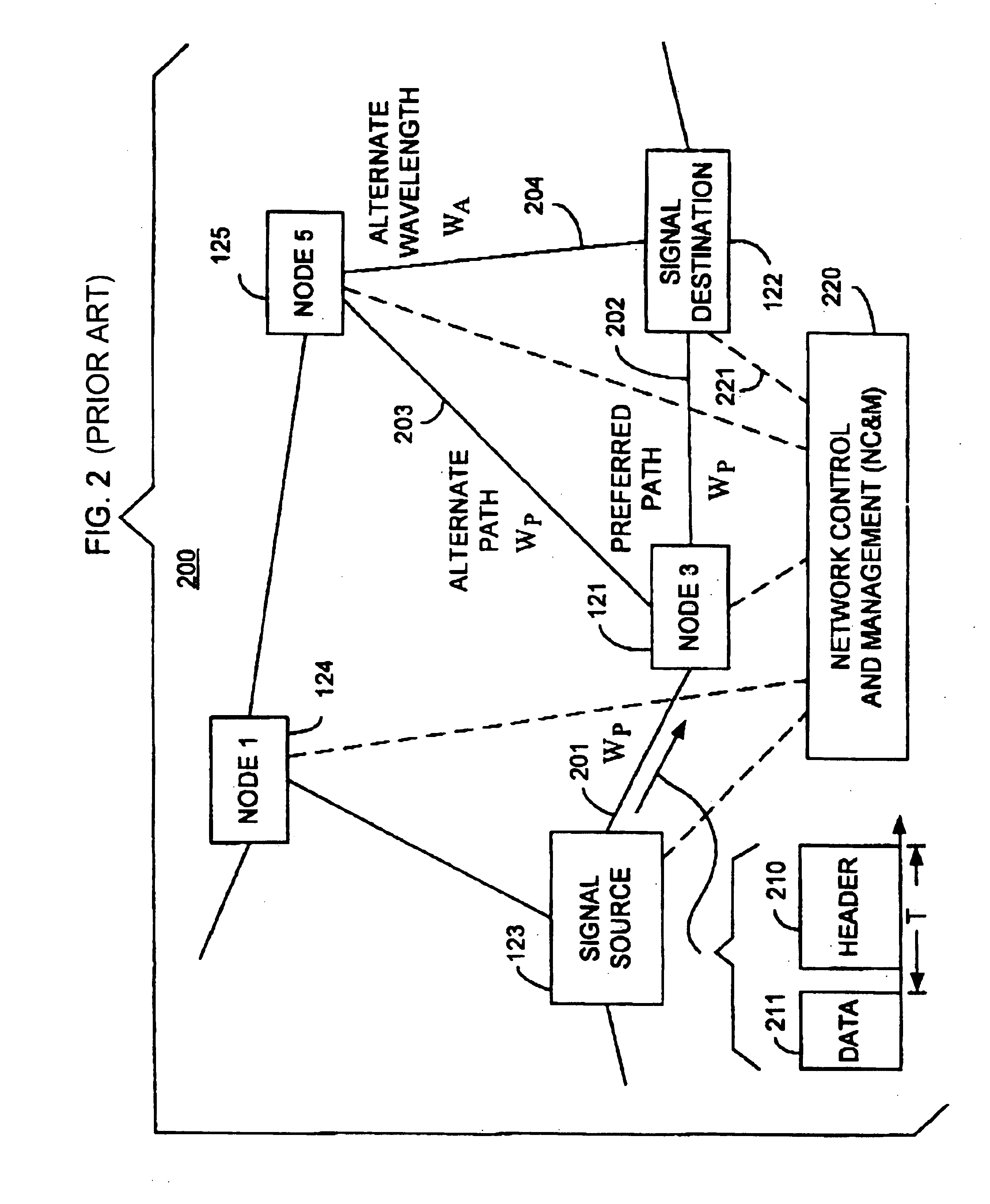Such efforts, while promising, have yet to fully realize this four-fold goal.
As discussed in Chang, there are a number of challenging requirements in realizing IP / WDM networks of the type required for the NGI initiative.
This limitation is inherent because the
optical switch disclosed in Chang is conventional in the general sense that each optical
signal arriving at an input port of the
optical switch is switched to a single output port.
It is clear from a detailed review of Chang that each header can convey only a
single label-switch state, that is, each header is incapable of providing multiple
label-switch states as part of the header information.
Thus Chang is devoid of teachings that are generally necessary for multicasting, or for responding to dynamic changes occurring within the network, such as an outage of a network node.
In addition, there are no teachings or suggestions in Chang to render an optical
multicast network both secure and survivable.
Thus, Chang has not provided the techniques nor circuitry necessary to engender a secure optical
multicast network for high capacity, resilient optical backbone transport networks where information, in units of per flow, per burst, or per packet, can be distributed securely according to assigned security levels and multicast addresses in the optical domain independent of data payload and protocols.
As alluded to above, there is an issue of how to effectively provide multiple headers or, equivalently, a header composed of multiple sub-headers conveying multicasting information.
Moreover, there is an additional issue of how to detect and / or re-insert a header which is combined with a data payload for propagation over the network using the same
optical wavelength.
However, using two wavelengths to transport data payload and header separately may not be practical in the following sense: in an all-optical DWDM network, it is preferred that the header, which may contain network operations information, travels along the same routes as data payload so that it can truthfully report the updated status of the data payload.
It is anticipated that the propagation distance will be substantially limited whenever the
system is deployed with
optical fiber because of phase dispersion effects in the
optical fiber.
Moreover, there are no teachings or suggestions of how to utilize the multiple sub-carriers to convey multicasting information.
(i) Non-destructive
fiber tapping can be the result of: (a)
fiber bending resulting in 1-10% of the optical
signal (all wavelengths if a WDM system are used) being emitted out of the fiber cladding and being gathered and amplified by an eavesdropper; (b) fiber-side fusion involving stripping the fiber cladding and fusing two fiber cores together as another way to perform signal interception (note that this is an extremely difficult technique to implement); (c) acousto-optic
diffraction involving placing acousto-optic devices on the fiber, which results in the leakage of 1-10% of the optical signal (all wavelengths) outside the fiber cladding.
Finally, denial of service can be the result of a variety of attacks.
First, the
chaotic behaviors are highly susceptible to changes in the initial conditions.
The situation becomes more complex for WDM networks deployed in the field, since cross-modulations in polarization, phase, and amplitude between multiple channels are bound to alter the initial conditions seen by the receiving users.
It is difficult to expect such synchronization to be successful for every packet in multiwavelength optical networks.
The presence of unstable ring lasers can cause power penalties to other
wavelength channels through EDFA
gain fluctuation, even though these EDFAs are
gain clamped.
Second, the
noise and the
chaotic behaviors are highly frequency dependent.
Such a
chaotic method, even if it works well for one particular
data format, cannot work well for a wide range of data formats.
Third, the
accommodation of chaotic optical carrier is made at the expense of useful signal bandwidth, network coverage, and network capacity.
To enhance the probability of synchronization, the chaotic optical carrier must possess reasonably high
optical power and consequently sacrifices the power available for the data.
A simple signal-to-
noise argument leads us to the conclusion that the network capacity and network reach will significantly drop due to excessive power in the chaotic carrier.
One of the fundamental problems of this technique is that it is slow (data rates of only a few Mb / sec can be accommodated) and it can only be applied to communications that span short distances (a few Km).
Finally, another problem that arises is whether an
attack (security breach) may be carried out that will be undetectable to the parties involved in the
secure communication (i.e., the polarization of the photons does not change when an eavesdropper taps part of the light).
The CDMA method can increase the
channel capacity by almost 10-fold over other access methods, but it is sensitive to both terrestrial
signal interference and the
noise added in-band by the simultaneous presence of multiple users.
 Login to View More
Login to View More  Login to View More
Login to View More 


